Simply ‘Mad’ About Cramer’s New NYSE Set
CNBC’s new “Mad Money” set says New York Stock Exchange and Jim Cramer
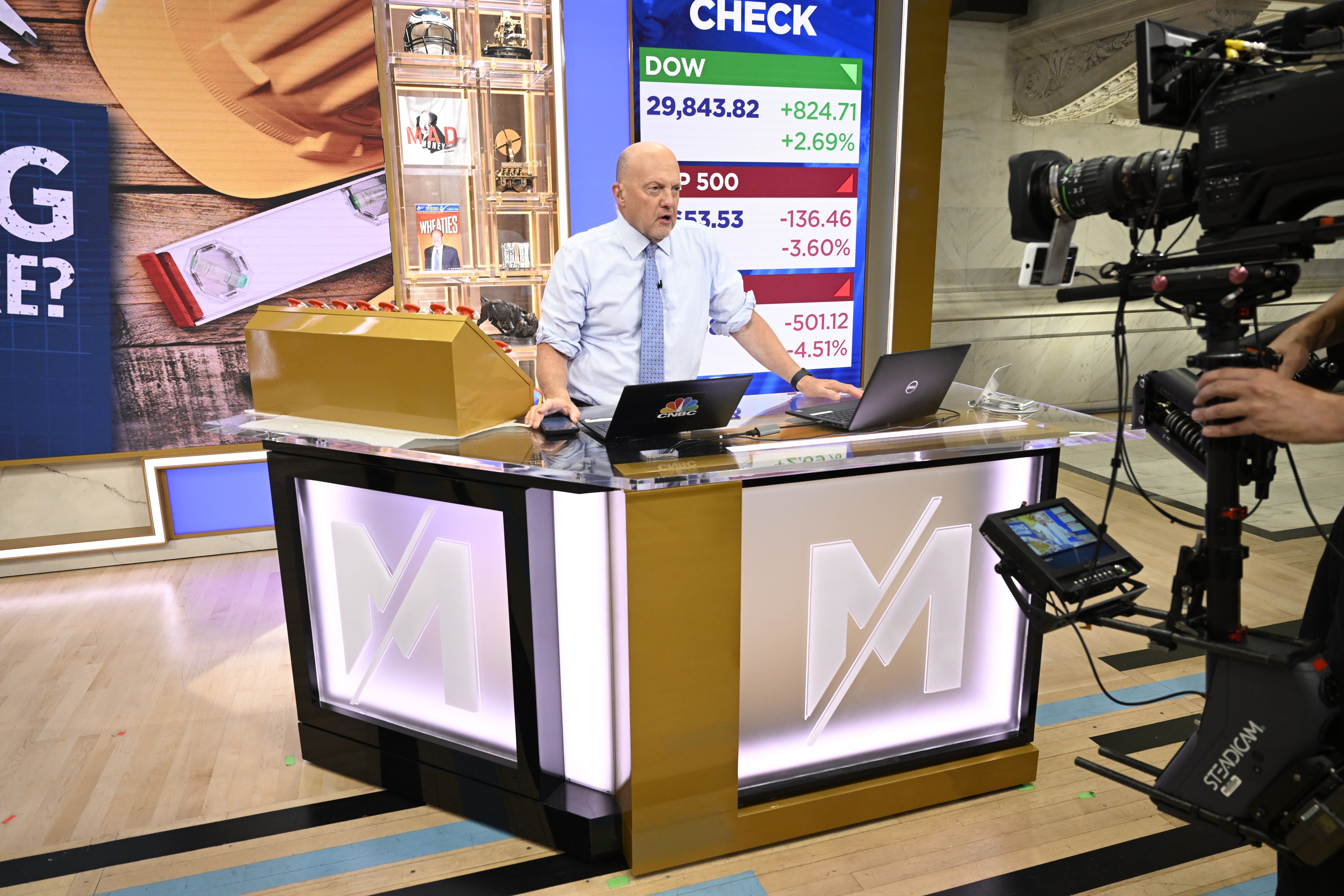
New York—Moving CNBC’s “Mad Money” and Jim Cramer from Englewood Cliffs, N.J., to the New York Stock Exchange in July may have seemed like the natural thing to do given the popularity and nearly 40-year presence of the show’s host in the trading community, but making the move a reality required far more than installing new production and control room tech.
A product of close cooperation between the broadcaster and the New York Stock Exchange, the project saw a major renovation of the 119-year-old building in an extremely high-profile area—a spot on the floor adjacent to where dignitaries ring the opening and closing bell to begin and end each trading day.
As a result, all work had to be done in relatively short bursts, well-defined windows of time after the close each trading day so everything appeared back to normal when specialists and floor brokers entered.
“The build took a long time because we had to work at night. Nothing could happen during the day,” recalls Steve Fastook, vice president of technical operations at CNBC. “No matter what we did at night, it had to be clean, put away, covered and look like the floor during the day.”
The project was conceived of in December 2021, and work began in April 2022. After a lengthy build, the new set made its debut July 18.
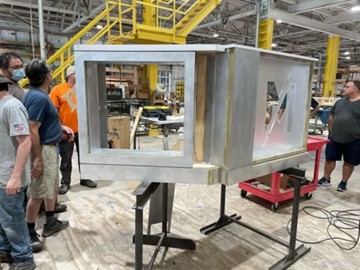
While building new sets and studios is nothing new to Fastook and the CNBC team, the project at the stock exchange was unique. Unlike others, the NYSE build required extensive renovation to portions of a national landmark.
“So, everything had to be different,” says Fastook. But despite the constraints and challenges, moving the show to the New York Stock Exchange simply made sense because, in Fastook’s words, Cramer “is part of the fabric of that place. It’s Jim’s natural habitat.”
Get the TV Tech Newsletter
The professional video industry's #1 source for news, trends and product and tech information. Sign up below.
Scope and Renovation
To make it possible for the host to work from the exchange and best use his talents required two spaces: the main set on the floor of the exchange where Cramer tapes “Mad Money” and a smaller space, dubbed Studio M (for “Mad Money),” away from the floor where the host can conduct private interviews with CEOs and other newsmakers who potentially might move the market if their interviews were overheard during a trading session.
John Casey Production Design was responsible for the look. “The set pays homage to its location,” says Fastook. Designed with the color palette and textures of the exchange, the set also showcases the history of the stock exchange and of Cramer.
For instance, a reporter’s cap used circa 1915 on the exchange to differentiate between media and traders is displayed in one of the on-set trophy cases, as are mechanical stock tickers. Items meaningful to the host and his history are displayed on the set as well, including a football helmet of his NFL favorite, the Philadelphia Eagles.
The project coincided with the beginning of the New York Stock Exchange’s own large-scale renovation of the trading floor. Part of the undertaking required transforming the exchange’s historic wooden trading posts. For Cramer’s morning show, Post Nine was reworked into a modern glass structure with Planar flat display panels, says Fastook.
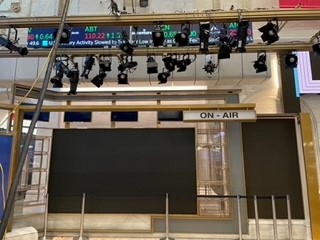
The preliminary work also entailed major repair and restoration of an original marble wall that now serves as the background of the set. “This marble is about 120 years old and had holes drilled in it. It had chips taken out. It was discolored from being hidden by the wood that covered it for 100 years,” he says.
A group of “amazing restoration” specialists hired by the NYSE brought new life to the old marble, “returning it back to its original color, filling the gaps and repairing the holes,” he says.
Workers with other specialties bought in by the exchange played important roles as well. “We worked with the New York Stock Exchange’s contractors, primarily ADCO Electrical, on things like technical infrastructure, power and fiber drops,” he says.
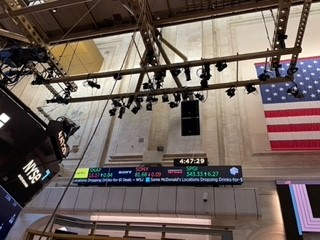
Prepping the area for the new set also required a modification of the exchange floor. While portions of the sets and infrastructure were being readied offsite, the exchange removed a trading post to make way for the main set.
“That left this really ugly looking floor that had been cut and built over. Everything had to be restored,” he says, adding that the necessary work on the floor created an opportunity to accommodate Cramer’s preferred way to work.
“Jim likes to work in a 360-degree fashion, that’s why we shoot it with a Steadicam mostly,” says Fastook. “He likes to move around. He has a chart on one side and the sound-effects board someplace else.”
Fastook, however, did not want an umbilical tether coming out of the desk that Cramer would have to think about whenever he moved. The solution required a master carpenter who works for the exchange to fashion a special piece of flooring that matched the existing floor and lifts out to accommodate the cabling when the space is transformed each trading day from part of the trading floor to the main set for shows. “When the desk (Cramer’s) is put away during trading hours, it looks like a beautiful wood floor, and when we open it up, Jim’s desk is freestanding,” he explains.
The ability to ready the space quickly for television was a major design consideration. “In about 20 minutes, we can transform the trading floor into a full-out TV production set,” says Fastook. “That happens every day.”
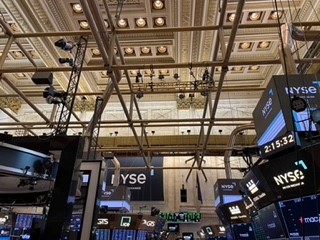
Set lighting illustrates the challenge of the fast turnaround while working within the constraints of a national landmark.
“Jim isn’t sitting in a chair, so he doesn’t have key lights and two back lights,” he says. “The whole area had to be lit so Jim could traverse around the set.
“At the same time, the ceiling is 110 feet high. So, we had to build an arrangement with a massive truss [and a smaller truss] that could drive down on motors and then drive back up on motors to be out of the way for New York Stock Exchange functions.”
Lowering the lighting truss over the set each day, however, raised the possibility lights might not be in the precise location needed for the show. To solve the problem quickly, four laser lights attached to make finetuning positioning fast.
“The lighting director flicks the laser lights when he is ready for the trusses to come down. He watches them intersect, and he knows he is perfectly aligned,” says Fastook.
Another key consideration in the lighting design of the trusses was the environment in which they must function. “Lighting was really difficult there. The room was lit for people, so it’s 3200 degrees K with all kinds of other color temperatures flashing in from monitors everywhere,” he says.
The overarching lighting concern, however, was making sure the trusses did not look out of place during the trading day. “Things had to be the right color. So, the trusswork is all gold, and the wiring had to be hidden. Everything had to be really buttoned up, which made it difficult,” he says.
Besides the Steadicam, the show, produced in 1080i HD, is shot with cameras mounted on two robotic pedestals on either side of the set. One of six robotic cameras mounted to Post Nine where Cramer does is morning show turns around and shoots the Lightning Round segment of “Money,” says Fastook.
Studio M and More
Studio M, where Cramer conducts private interviews during the trading day, is a much smaller space off the floor of the exchange. Its centerpiece is a 109-inch 0.9mm Planar screen, and an 80-inch Planar touchscreen that displays a telestrator for the host to explain stories. The background combines video and artwork of the front of the exchange. Doors and windows separate the studio from the floor to ensure privacy, says Fastook.
To support the technical requirements of the new sets, the broadcaster and the exchange converted two phone booths used “in the old days when traders needed to have a private conversation off the floor” into a space for racks and equipment, he says.
“They were made out of this dark wood, and they had frosted glass that we couldn’t bear to throw away,” says Fastook.
Carefully removing and deconstructing the phone booths, Fastook’s team preserved the original material and fashioned a wooden panel that, when removed, reveals the racks of infrastructure supporting the sets. The team repurposed the glass as well, backlighting it with LEDs. “It’s beautiful. It is off to the side, but you can see it on set,” he adds.
Different goals guided how audio from both sets would be treated. For the main set, the idea was to “celebrate the sound on the floor,” although trading is finished by the time the show is produced so the din is lower than during the trading day. For Studio M, the structure of the exchange “pretty well insulated” the space from those sounds during the day, but to complete fully accomplish acoustic goals CNBC built “double-thick” walls, says Fastook.
“It’s really not a matter of noise during production; it’s to prevent people from listening in,” he says.
The project also required installation of a new 128 x 128 routing switcher to replace the existing 64 x 64 unit. However, delivery of the router, as well as other parts and pieces of the new infrastructure, has been plagued by supply chain interruptions. For the moment, CNBC is using the existing router and patches, he says, adding, “even things like light fixtures, we had to go to multiple vendors to source.”
CNBC shares control of the existing router –and will of the new router—with the exchange. “Basically, everything on the floor is a router source and destination. We can feed the big wall; we can feed the vertical wall; and we can feed the wall in the back to telestrators,” he says.
When not in use by CNBC, the exchange takes control of the router, feeding its digital signage system into the matrix to route to the displays used during shows for the broadcaster’s productions from the exchange, he says.
Overall, the project and the sets represent a highlight in Fastook’s career and a feather in the cap of CNBC. “We’re really proud of the classiness of the set and that you see that you’re on the floor of the New York Stock Exchange while also saying it’s Jim’s space.”
Phil Kurz is a contributing editor to TV Tech. He has written about TV and video technology for more than 30 years and served as editor of three leading industry magazines. He earned a Bachelor of Journalism and a Master’s Degree in Journalism from the University of Missouri-Columbia School of Journalism.

